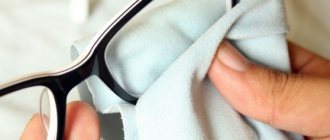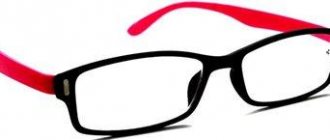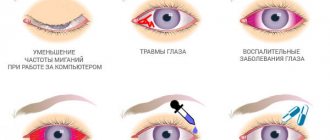Just a couple of years ago, the counters of opticians and even ordinary haberdashery stores were literally “inundated” with glasses of an unusual model. Instead of glass, these glasses had plastic lenses, completely strewn with perforations in the form of small holes-holes made in a certain way. Surely, many remember what we are talking about, but still do not understand why such an accessory is needed.
Many functions were attributed to glasses with holes, including making it easier to work at the computer. However, their real purpose is to train the eyes, get rid of visual fatigue, and relax the organ of vision. But let’s figure it out together whether these miracle simulators really help.
User reviews
Reviews found on the Internet from owners of such training glasses are very ambiguous. Some confidently claim that glasses really help maintain a calm, functional state of the eyes. Others are quick to accuse manufacturers of releasing another “dummy” onto the market, the entire benefit of which is an advertising gimmick.
However, independent ophthalmologists state that there are actually benefits from such correction models. The main thing is to remember that glasses with holes are not therapeutic and certainly cannot replace ordinary glasses with diopters. Even if you regularly wear such perforated lenses, this will not correct your vision and will not return it to its original state.
Their task is to eliminate defects in the optical system of the human eye, which are caused by excessive visual fatigue. Glasses are designed to relax and relax the eye muscle, relieve its excessive tension, as well as for preventive training of the eye lens.
Many users claim in their reviews that perforated lenses have healing properties. However, experts have a different opinion on this matter. On the contrary, ophthalmologists do not recommend pinning too much hope on perforation.
The holes only help to effectively relieve eye strain and they are very useful for those who constantly work at the computer, count or read a lot. With the help of glasses with holes you can get rid of headaches quite easily. In addition, they are an excellent prevention of the development of refractive errors - myopia and farsightedness, when good vision is still preserved. But, with regards to the therapeutic effect, even what is observed is short-lived. It is explained by the fact that due to artificial focus enhancement, the image in glasses becomes clearer. This effect persists for some time after removing the glasses, but then completely disappears.
Perforation glasses
Perforation Spectacles
You have unusual glasses in your hands. To understand this, look into the distance (if you use glasses, take them off), then repeat the same, using the suggested glasses, for a few minutes and take them off. Noticed an improvement in image clarity? Lensless glasses are perforated - holey, at first glance similar to ordinary sunglasses. Having examined them carefully, you will understand that they do not contain any corrective glasses with diopters or light filters. Instead, there are rows of small hexagonally arranged holes in opaque plastic surfaces, made using laser technology. By putting on glasses, you will be convinced that you can freely see all the surrounding objects, moreover, you can freely read the smallest text, even if you have various vision problems (astigmatism, myopia, farsightedness, including age-related so-called presbyopia). Of course, your eyes need to get used to looking through the holes. In fact, the brain gets used to looking through the holes. At the same time, people with nearsightedness and farsightedness or with astigmatism see more clearly than they saw before.
Design features of glasses:
The important thing is the shape of the holes and their required diameter, which varies from the center to the periphery. In this case, the shape of the holes should be exclusively conical, which distinguishes them from crude fakes having a cylindrical shape. This shape of the holes reduces the glare effect, providing high clarity of the object in question, and increases the viewing angle.
A cutout “window” in the lower part of the lens provides illumination of the eyeball with diffused light, which improves the hemodynamics of the eye (blood movement through the vessels), and also makes it possible to see close up through the “window” without removing glasses.
The action of perforation glasses is based on the principle of diaphragm. The small opening of the glasses increases the depth of field of the image on the retina and weakens the flow of scattered light entering the eyes by 4-5 times, as a result of which, even in an eye with a refractive error, the image of an object falls into the zone of greatest visual acuity of the retina. Through the central optical zone of the eye, only light from the object in question falls on the retina, causing the effect of a sharp increase in resolution. As a result, the ciliary muscle relaxes, compressing the lens of the eye. This allows the lens to change its curvature (refractive power) without much strain, increasing visual acuity at distance and near by no less than 2-3 diopters. (That is, there is an increase in accommodation of the visual organ). This allows you to see small objects and letters without accommodation and the use of magnifying glasses. In this case, a moderate relaxation of the eye muscles occurs, and it becomes possible to train the weakened ciliary muscles.
What is the physical effect of aperture based on?
The fact is that, in a simplified form, the optical system of the eye can be represented as a converging lens (with an optical power of approximately 60 diopters), which focuses the image of the outside world onto the inner shell of the eye - the retina. If you look at the figure below, you will notice that a beam of rays parallel to the axis of the lens is refracted the more strongly, the further the beam is from the optical axis:
Rays traveling exactly along the optical axis through the center of the lens are not refracted at all. This is the secret of holey glasses. In the following figure you see a simplified diagram of perforated glasses with one hole:
As can be seen from the figure, perforated glasses transmit only a narrow beam of rays, which are practically not refracted by the eye. All other rays are cut off by the opaque part of the glasses. This means that a person looking through perforated glasses becomes much less sensitive to such refractive errors of the eye as myopia, farsightedness, and especially astigmatism. The person feels that his vision has improved. Moreover, the smaller the diameter of the holes in the glasses, the higher the visual acuity in them.
Usefulness and effectiveness of perforation glasses.
For: I. refractive errors: 1. Myopia 2. Farsightedness 3. Astigmatism 4. Spasm of accommodation 5. Age-related farsightedness - presbyopia II. Amblyopia III. cataract IV. abiotrophies – dystrophies, retinal degeneration
I. _ In the first case, the effectiveness lies in increasing the depth of field of the image, and therefore visual acuity, minimizing, “zeroing” the optical power of the refractive error. So, for example, a person with myopia or farsightedness of 2 dioptres, seeing well in glasses equal to 2 dioptres, respectively, wearing perforated glasses in place of lens glasses, will also see well without lenses. This is especially pronounced with astigmatism (deformation of the cornea). In this case, perforated glasses do not have a healing effect, as is attributed to them by many companies. The main advantage of these glasses is prevention, not treatment. Preventatively, they protect the eyes, including the brain, from visual strain. This is their main role. For this reason, you can look at both the TV and the monitor screen much longer than usual while wearing perforation glasses. In fact, perforation glasses, protecting the eyes and brain from overstrain, perform a passive part of prevention. The active part of this prevention is provided by optical-physiological massage of the accommodative muscle of the eye, carried out using the optical accomodotrenor ATO. Thus, the combination of perforation glasses and accomodotren optical ATO makes the therapeutic and preventive technology complete and the most effective.
+
II . In the second case, the effectiveness lies in the fact that even in an eye with a refractive error, the image of an object falls into the zone of greatest visual acuity, which is very important for starting intensive treatment of functional underdevelopment of the retina. In this case, targeting the object at the central part of the retina, perforation glasses, performing the passive part, prepare the retina and brain for the active part - the therapeutic one, carried out, for example, by the method of panoramic figured blinding fields using the Panorama ophthalmic simulator. For the same purpose, it is preferable to use perforation glasses while watching TV and computer programs.
+
III . In the third case, the effectiveness of perforation glasses lies in the fact that, due to the diaphragmatic effect, the eye itself “gropes” and finds the most enlightened area of the cataract lens.
IV . In the fourth case, perforation glasses help to search in the fundus of the retina for a less damaged part of the retina with the highest function in terms of visual acuity. The effect of the image of an object falling into the zone of greatest visual acuity in the normal state is reduced due to absent-minded attention. In perforated glasses, this effect occurs automatically due to the reduction in the size of the light distance circles on the retina by small holes.
The scientific basis for the use of perforation glasses.
During the development and implementation of glasses, the technical characteristics, design features of glasses, basic visual functions (resolution, accommodation, dark adaptation, field of vision before and after a course of treatment (from 10 to 30 days, one hour of daily use of glasses) were studied)
The dynamics of the subjective state of the organ of vision during the use of glasses was assessed.
It has been shown that for the effect to manifest itself, a certain time is necessary (getting used to the glasses) in order to eliminate the sometimes occurring Scheiner phenomenon (monocular double vision), a short-term disturbance of binocular vision and the perception of “holes” in front of the eyes.
Very often, after a few days of daily use of these glasses, many noted that they could do not only without them, but also without ordinary corrective glasses. All this allows, along with other methods, to use new glasses in the treatment and prevention of many visual disorders.
No side effects were observed with the use of these glasses. How to get used to it, where to start using perforation glasses? You need to train your eyes gradually, with maximum relaxation, studying objects with a glancing glance, without peering into their details. Use commercial breaks to practice focusing your eyes on near and far objects. Look at a nearby object (the watch on your hand, a newspaper, any thing), then look at the image outside the window of the room, then again at the nearby object and again at the TV screen. Repeat these exercises every commercial break. It is important not to focus on the holes. Try turning your head slightly and closing your eyes for a few seconds at a time.
For visual impairments, training should begin with examining known and well-lit objects from a distance of 2-5 meters 3-4 times a day for 5-10 minutes. Then increase the time daily by 5 minutes, gradually increasing the duration to 30-40. Moreover, if you are nearsighted, it is best to watch TV shows or look into the distance; if you are farsighted, it is best to read and write.
Watch yourself and avoid staring, motionless gaze. A motionless gaze frozen at one point is evidence of fatigue and overstrain of the eye muscles. Make your eyes work by changing your focus as often as possible.
Studies have shown that it is possible to relieve spasm of accommodation (false myopia) by 3-4 D, correct astigmatism quite well (up to 5D), significantly improve contrast and color sensitivity, and reduce the power of glasses when correcting presbyopia.
No side effects were observed with the use of these glasses.
Disadvantages of training glasses
The main disadvantage of corrective glasses is their small light transmitting area. It is necessary to mention here that the plastic lenses of such glasses block approximately 90% of the light flux going to the retina, and this will adversely affect vision if you wear glasses for a long time.
You also cannot help but listen to the opinion of critical experts who argue that perforations in the plastic lens prevent the eye muscles from working, immobilizing them, which worsens vision even more. In addition, it is worth considering that training visual functions in glasses with holes is contraindicated for astigmatism, cataracts and glaucoma. Therefore, before purchasing this simulator, consultation with an ophthalmologist is required.
The principle of operation of glasses with holes
Visual muscles, like any other, need to be constantly kept in shape.
Vision deteriorates due to atrophy of one type of eye muscle: transverse, longitudinal or oblique. In order for it not to continue to fall, and in some cases, to return to normal, the eye muscles should be given physical activity. However, the load on the eye muscles is very different from the load on the muscles of the body. In order to keep them in good shape, you need to do special exercises for the eyes twice or thrice a day. Her technique is widely available. In addition, perforation glasses will help train the eye muscles.
The operation of the glasses is based on the principle of limiting the luminous flux, which is achieved using small holes in plastic opaque lenses. The effect on vision is achieved by focusing the gaze on the so-called manipule - the point of best vision. Thus, the depth of field increases, which leads to the fact that the projection of objects falls into the zone of greatest visual acuity of the retina.
In addition, the improvement in vision in glasses with holes is due to a decrease in the area of \u200b\u200bthe light flux that enters the eyes. This leads to a decrease in the magnitude of pupil constriction and an increase in the ability of the eye muscles to accommodate.
Unfortunately, the main effect of using perforated glasses is achieved while wearing them. After they are removed, visual acuity returns to its previous values.
How to properly use glasses with holes?
Training with training glasses should be carried out on a regular basis in a limited time period - not for long. At the same time, each model of such glasses has its own detailed instructions, which describe why and how it should be used in everyday life. But there are a number of rules that must be followed when having any type of glasses with holes:
- Use exercise equipment only in bright, indirect lighting. It is better if it is daylight, but soft electric light is also quite acceptable.
- Wearing glasses with holes should not exceed 2-3 hours every day. Otherwise, eye coordination may be seriously impaired.
- It is imperative to accompany training in glasses with perforations by performing special gymnastic exercises for the eyes.
- When working at a computer for a long time, every hour you need to take a short break and put on training glasses for literally 5-10 minutes. This will help relax the eye muscles and relieve tension.
And of course, when using glasses with holes, be sure to regularly see an ophthalmologist to monitor your training results and adjust the intensity of your training.
By contacting the Moscow Eye Clinic, each patient can be sure that some of the best Russian specialists will be responsible for the results of treatment. The high reputation of the clinic and thousands of grateful patients will certainly add to your confidence in the right choice. The most modern equipment for the diagnosis and treatment of eye diseases and an individual approach to the problems of each patient are a guarantee of high treatment results at the Moscow Eye Clinic. We provide diagnostics and treatment for children over 4 years of age and adults.
You can find out the cost of a particular procedure or make an appointment at the Moscow Eye Clinic by calling 8(499)322-36-36 or using the online appointment form.
How do perforation glasses work?
vote
Article rating
Punch glasses are something of a miracle. They allow anyone with imperfect vision to see clearly immediately without the need for corrective lenses.
You can check this phenomenon right now. Make a fist and bring it to your eye and close your other eye. Open a small hole in your fist so you can see through it.
Surprisingly, through this hole you will be able to see clearly!
It's a bit like a miracle, isn't it?
In fact, there is plenty of evidence that wearing pinhole glasses for just 15 minutes a day can naturally improve your vision . While ophthalmologists are reluctant to conduct the necessary clinical trials to be sure, our personal experience leaves little doubt that pinhole glasses can improve vision with regular use.
In fact, we believe that:
Training glasses are a great addition to your daily vision training.
Perforated glasses, or glasses with a hole, are an alternative to regular glasses to improve vision. The shape and design are similar to the usual ones, the only difference is in the lenses. Instead of glass, perforation glasses use plastic with small holes, each of which allows only a tiny beam of light into the eye.
Trainer glasses are worn just like regular glasses. Instead of glass or plastic lenses, they use opaque plastic. A person looks through pinholes in these plastic “lenses”.
To fully understand how pinhole glasses work, we need to look at how the eye processes light rays to form an image.
How the eye works
Our ability to see is activated when light bounces off the object we are looking at and enters the eye. When light enters the eye, the light beam is not focused. The first step involves focusing light rays onto the retina, the light-sensitive layer inside the eye. When focused, the light stimulates cells to send millions of electrical impulses along the optic nerve to the brain. The part of the brain located in the back of the head (visual cortex) interprets impulses, which allows us to see an object.
Refraction of light and its importance
Light entering the eyes is first deformed, or refracted, by the cornea - a transparent window on the outer front surface of the eyeball. The cornea contains most of the optical power, or refractive power, of the eye.
After passing through the cornea, the light beam is bent again - for more precise focusing - on the lens inside the eye. The lens focuses light onto the retina. This occurs with the help of the ciliary muscle, which changes the shape of the lens, stretching or flattening it, focusing the light beam on the retina.
This adjustment of the lens, called accommodation , is necessary to keep both near and distant objects in the spotlight. The process of bending a light beam to produce a focused image on the retina is called refraction. Ideally, the light is refracted, or redirected, so that the rays form an exact image on the retina.
Currently reading: Eyeglasses
Most vision problems arise from problems with light refraction .
In myopia ( nearsightedness ), a beam of light forms an image on the front of the retina. With hypermetropia ( farsightedness ), rays are concentrated behind the retina. With astigmatism , the curvature of the cornea is heterogeneous, as a result of which light rays are focused on several areas of the retina, which is why a clear image is not formed on it, and vision becomes blurred. As age , it becomes more difficult for us to read or do small manual tasks. This condition is called presbyopia , in which the lens loses its flexibility, and therefore its ability to refract light.
Ideal vision with the naked eye requires the lens to focus light rays from different angles onto a single point directly on the retina, located at the back of the eye. In people who suffer from refractive problems, such as weakening of the lens or deformation of the eyeball, diverging rays of light focus in front of or behind the retina, causing an out-of-focus image to be created on the retina itself. This area of out-of-focus image is sometimes called a “ blur circle .”
How do pinhole glasses work?
Perforation glasses (trainer glasses) are a natural method of vision correction that will never harm!
For example, glasses and contact lenses correct vision only superficially and, as is known, only worsen it over time.
Although they are called glasses, pinhole glasses are not made of glass and do not involve the use of corrective lenses. Instead, black plastic (or metal) with pinholes is used.
Buy glasses
So how do these glasses work?
In optical terms, perforation trainers reduce the effects of eye focusing problems by increasing the optical depth of field (decreasing the aperture size).
The essence of their action is that each hole in the glasses allows only a thin beam of light to pass through. At the same time, the size of the light spot that does not fall into the focusing area on the retina decreases, that is, the depth of field increases.
The “lenses” of perforation glasses are plastic with holes with a diameter of about 1-1.5 mm, equidistant from each other. The average pupil diameter in daylight is about 4 mm. Each hole admits a thin, straight beam of light; these beams are combined into one light stream, which enters the pupil and then the lens. This will reduce the appearance of any refractive errors because the size of the “blur circle” on the retina is proportionally reduced. As a result, the resulting visual image becomes clear, bright and crisp.
Currently reading: Suggestion of surgery to treat astigmatism
| Naked eye with poor vision | Eye with low vision wearing perforation glasses |
| In an eye with low vision, the light rays entering the lens cannot focus on the same area of the retina. For example, rays a, b, f, g must be better focused to fall into the same plane as rays c, d, e, located closer to the center. Rays c, d, e, as a rule, are always in focus, regardless of the condition of the eye, and always form a clear image on the retina. But this clear image is spoiled by the “blur spot” formed by rays a, b, f, g. | When using a perforated lens, the image on the retina is formed only by rays c, d, e, and there is no blur circle and does not interfere with the creation of a clear image. Therefore, with the help of pinholes, many focused images form a sharp and clear image on the retina. In addition, it does not require any effort from the eye muscles, since the rays entering the eye are already focused. That is, an indirect relaxing effect can be observed. |
The idea of perforation glasses is based on the principle of natural reflexes - the same effect is achieved when we squint to see a clearer picture. The eyelids cover the top and bottom of the eye, filtering out rays of light entering the lens. Thus, only rays from the center, as well as from the right and left sides, enter it. The picture we get as a result is brighter and clearer, because the difference in the level of illumination gives it contrast. Punch glasses , of course, relieve the eye strain that comes from squinting; In addition, they more effectively block “extra” light rays to create a clear and bright image in the eye.
Try looking through any tiny hole and you will feel this effect. When viewed through the eye of a needle, blurry images become clearer because the number of peripheral light rays responsible for blurriness is reduced. With multiple holes positioned properly, you'll get a crisp, clear picture without having to strain to peer through one tiny hole. Regularly wearing perforation glasses trains the eye muscles and helps the eyes relax after a hard day at work. This is especially useful for those who spend a lot of time looking at a computer or TV screen. Punch glasses train your eye muscles, just as other forms of exercise train the rest of the muscles in your body.
Currently reading: How this method has helped others. Seeing Without Glasses.
Improved vision
For people with nearsightedness, farsightedness, presbyopia, astigmatism or cataracts, training glasses provide instant relief in the form of improved vision. You will really feel the difference in focusing ability from a distance - for example, when watching TV or reading a blackboard in a classroom. Those who wear trainer glasses report nearly perfect vision and only minor difficulty reading text or watching TV without additional corrective glasses.
How perforated glasses restore vision
What are perforation glasses for?
1. Preventing “computer vision syndrome” . If you work at a computer for a long time, you probably feel symptoms such as overstrain and dry eyes, fatigue, headaches, blurred vision, and double vision. All this leads to “near vision stress.” Computer glasses reduce glare from your monitor, help relax your eyes, and increase your depth of field of vision and natural focusing ability (also known as accommodation).
Because trainer glasses minimize the amount of light entering the eye, they can be used to protect against the sun or very bright light. In addition, they help relieve eye strain that occurs when working on a computer for a long time.
2. Relieving eye strain and improving vision . By wearing perforation glasses, we get clear focus on distant objects without straining the eyes. This helps reduce myopia. Some users of these glasses report that wearing pinhole glasses for just 15 minutes a day can significantly improve their vision in about 4 weeks. If you are farsighted, try reading and writing with pinhole glasses. And myopic people should, for example, look into the distance or at the TV screen while wearing perforation glasses.
Cataract
People with cataracts often see better through pinhole glasses. Cataracts interfere with the normal penetration of light into the eye, but training glasses can even in this case significantly improve vision.
If a person has chronic myopia with values of more than 6 diopters, then perforation glasses will not be able to bring significant improvement due to severe problems with refractive power.
When trainer glasses are used for reading or other close work, they reduce the amount of accommodation or focusing power needed for clear vision. Many studies have pointed to excessive accommodation as the cause of acquired myopia.
Obviously, any factor that can reduce the accommodative force - including pinhole glasses - is a useful weapon in the fight for good vision. That's why (and also because the optical business doesn't want to deal with them) we decided to promote the idea of using pinhole glasses on our website. These glasses can become your main tool for preventing myopia.
These time-tested training glasses will make reading and other small work at close range more convenient for you. They will easily replace expensive optical glasses, and at the same time will be durable enough to serve you for a long time.
Reviews from doctors about this invention
Dr. David Michael, author of Vision: Optics and Refraction:
“Micro-holes reduce distortion and scattering of the light beam, highlight favorable areas of the damaged cornea and increase depth of field.”
Dr. Norman Bies, author of the book “Correction of Defective Vision”:
“The increased depth of focus with pinholes gives patients a significant increase in reading distance.”
Buy high quality perforation glasses
Our doctors who will solve your vision problems:
Fomenko Natalia Ivanovna Chief physician of the clinic, ophthalmologist of the highest category, ophthalmic surgeon.
Surgical treatment of cataracts, glaucoma and other eye diseases. Yakovleva Yulia Valerievna Refractive surgeon, specialist in laser vision correction (LASIK, Femto-LASIK) for myopia, farsightedness and astigmatism.
Gigineishvili Darejan Nugzarevna Retinologist, retina specialist, conducts diagnostics and laser treatment of retinal diseases (dystrophies, ruptures, hemorrhages).
Mironova Irina Sergeevna











